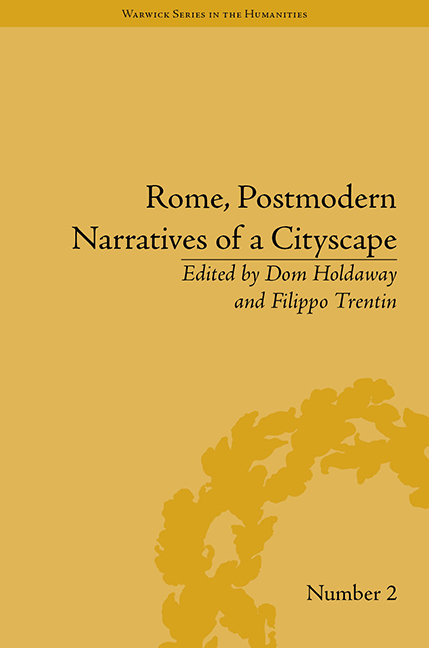Book contents
- Frontmatter
- Contents
- Acknowledgements
- List of Contributors
- List of Figures
- Introduction: Rome, Postmodern Narratives of a Cityscape
- Part I Knowing Rome
- Part II Fragmented Topography
- Part III Situating Rome
- 7 Ecclesiastical Icons: Defining Rome through Architectural Exchange
- 8 ‘Roma Interrotta’: Postmodern Rome as the Source of Fragmented Narratives
- 9 Las Vegas by Way of Rome: The Eternal City and American Postmodernism
- Notes
- Index
8 - ‘Roma Interrotta’: Postmodern Rome as the Source of Fragmented Narratives
from Part III - Situating Rome
- Frontmatter
- Contents
- Acknowledgements
- List of Contributors
- List of Figures
- Introduction: Rome, Postmodern Narratives of a Cityscape
- Part I Knowing Rome
- Part II Fragmented Topography
- Part III Situating Rome
- 7 Ecclesiastical Icons: Defining Rome through Architectural Exchange
- 8 ‘Roma Interrotta’: Postmodern Rome as the Source of Fragmented Narratives
- 9 Las Vegas by Way of Rome: The Eternal City and American Postmodernism
- Notes
- Index
Summary
It is comprised, not of proposals for urban planning, naturally, but of a series of gymnastic exercises for the Imagination whose course runs parallel to that of Memory.
G. C. ArganDuring the late 1970s a group of twelve architects – Piero Sartogo, Colin Rowe, Robert Venturi with Denise Scott Brown, Michael Graves, Costantino Dardi, Antoine Grumbach, James Stirling, Paolo Portoghesi, Romaldo Giurgola, Robert Krier, Aldo Rossi and Léon Krier – were brought together for an exhibition that redrew Giambattista Nolli's 1748 map of Rome and sought to use this reinterpreted map in the production of visionary drawings of architecture and urbanism.
Nolli's map was the first attempt to produce a complete outline of Rome, his adoptive city. Created under the commission of Pope Benedict XIV, the map, entitled the ‘Nuova Topografia di Roma’ (New Topography of Rome), has since become an important and highly influential representation. The city itself was represented in twelve connected segments, and the map's frame was an architectonic–allegorical capriccio that represented the two Romes: on the left, the antique (and pagan) Rome, on the right, the modern (and sacred) one. It was commissioned to be a precise technical work, intended by the pope as a rational outline of the city's social and legal administration.
- Type
- Chapter
- Information
- Rome, Postmodern Narratives of a Cityscape , pp. 155 - 170Publisher: Pickering & ChattoFirst published in: 2014



